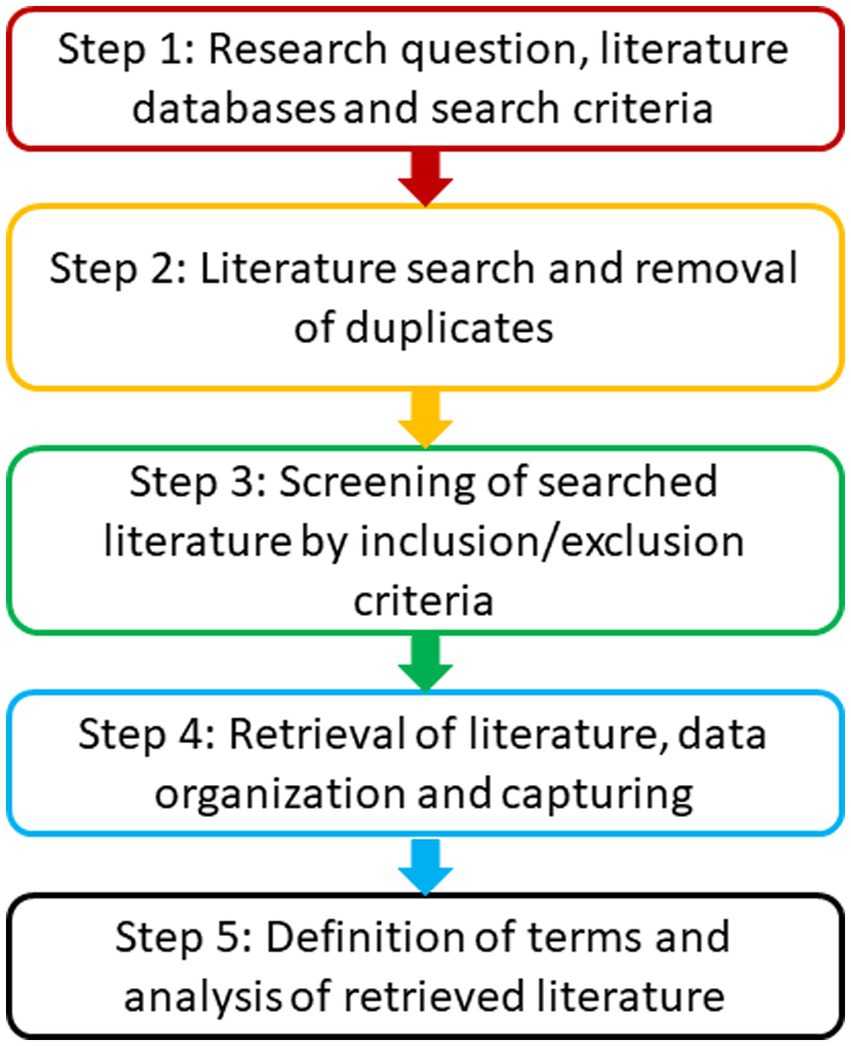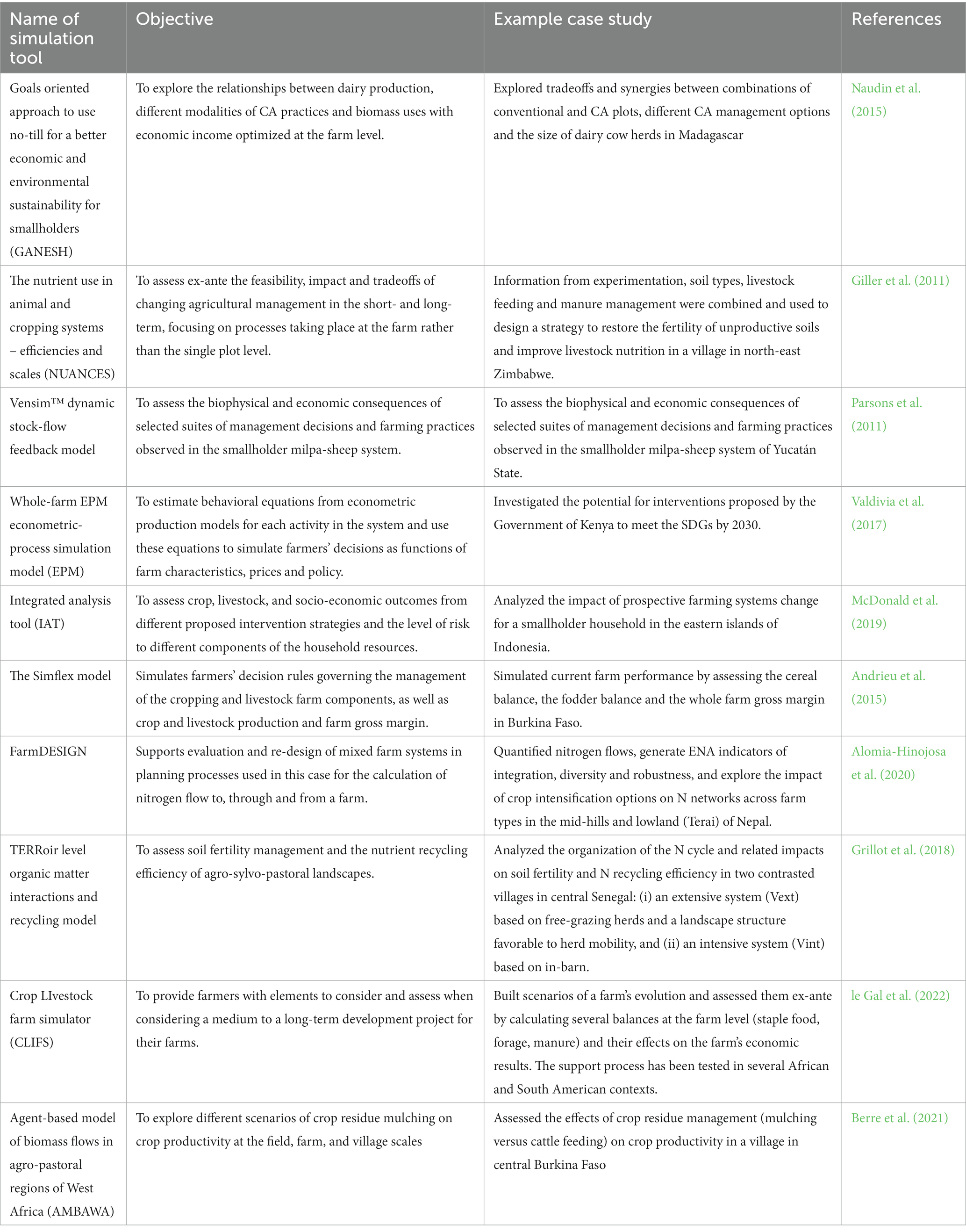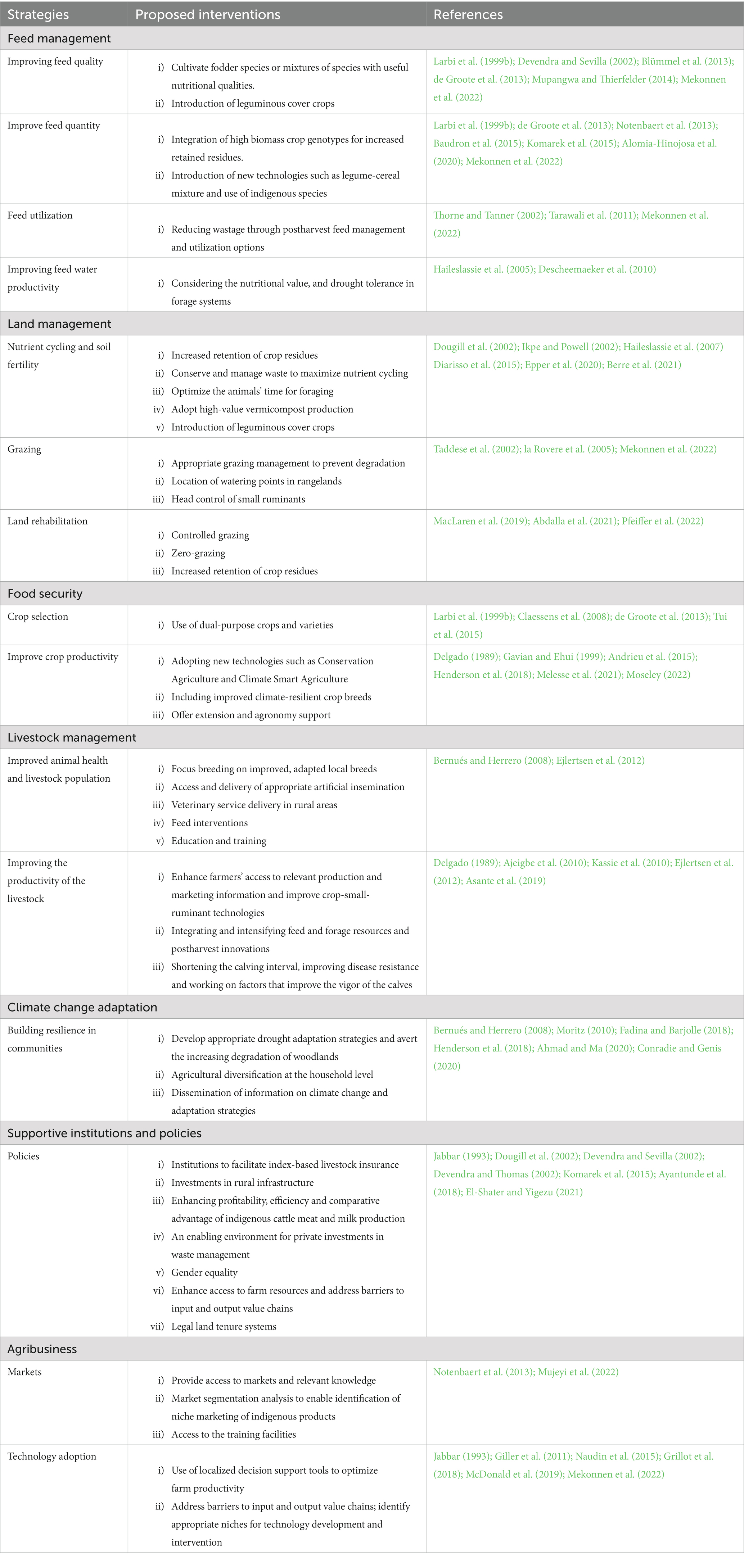- 1International Water Management Institute (IWMI-SA) – Southern Africa Regional Office, Pretoria, South Africa
- 2Centre for Transformative Agricultural and Food Systems, School of Agricultural, Earth and Environmental Sciences, University of KwaZulu-Natal, Pietermaritzburg, South Africa
- 3International Water Management Institute, New Delhi, India
Mixed farming systems (MFS) are the main food source and exist across almost all agroecological regions in the Global South. A systematic scoping review was conducted to identify the status of integrated crop-livestock research in MFS of the Global South. The Preferred Reporting Items for Systematic Reviews and Meta-Analyses protocol was used to identify 210 studies (excluding reviews) addressing productivity, resilience, challenges, opportunities, and perceptions of integrating crops and livestock in the Global South from the Scopus and Web of Science database. Publication details, problem statement, experimental details and research outcomes of each study were extracted into an MS. Excel sheet. Descriptive methods such as frequency counting and the word frequency cloud were used to analyze the data and identify emerging themes. Integrated crop-livestock research was mostly conducted in sub-Saharan Africa and Asia and not much from North Africa and the Caribbean. The integrated research has been focused on farm production of human food and animal feed by smallholder farmers and soil productivity. Maize was the most dominant crop, while for livestock, it was sheep and cattle. The integrated crop-livestock research seeked to address various challenges, including the growing demand for food and fodder, water scarcity, land scarcity and degradation, climate change, disease outbreaks and social changes. The review summarized proposed strategies and approaches to improve the efficiency of MFS in the Global South. Under the current challenges, feed quality and supply can be improved through adoption of high biomass, climate smart and improved drought-tolerant fodder crops. Using crop residues incorporated in crop fields for improved soil organic matter and controlled grazing were some strategies suggested for land rehabilitation. Building the resilience of smallholder farmers in MFS can be done through diversification and ensuring access to information, markets and finance. Policies that promote the business component, i.e., markets, training, gender equality, private investments, tenure systems and technology adoption were identified for the sustainability of MFS. There is need for research that integrates crop-livestock systems and natural resource management innovations and that evaluates sustainable intensification strategies to meet productivity goals without compromising social and ecological outcomes in MFS.
1. Introduction
A mixed farming system (MFS) is whereby farmers keep crops and livestock on the same farm. In MFS, annual and perennial crops, tree species, ruminants and non-ruminants are integrated on the same farm to reduce production risks, improve food security and enhance income (Sumberg, 1998). In MFS, crop, livestock and/or fish production activities are managed by the same economic entity, such as a household, with animal inputs (for example, manure or draft power) being used in crop production (Rufino et al., 2006) and crop inputs (for example, residues or forage) being used in livestock production (Latham, 1997; Rufino et al., 2006). Mixed farming systems exist across almost all agroecological regions in the Global South despite various business models, research and training leaning toward specialized forms of farming (FAO, 2020). Mixed farming varies depending on social and cultural beliefs, market prices, local policies, technological advances and the environment.1
Mixed farming systems are the main food source in the Global South (see Footnote 1). Factors such as climate change (Thornton et al., 2009), population pressure, urbanization, water scarcity, changing diets, and volatile food prices (Steinfeld et al., 2006; Hazell and Wood, 2008; Seré et al., 2008) continue to threaten these systems together with livelihoods of smallholder farmers (Giller et al., 2021). Projections show that to meet the rising demand for food, agriculture (livestock and crop), global water consumption and agricultural land are expected to increase by 60% and approximately 70 million ha, respectively (Boretti and Rosa, 2019; High-Level Expert Forum, 2009; United Nations Convention to Combat Desertification, 2022). Crop–livestock systems must be transformed and intensified along productive and sustainable pathways. This aligns with achieving global targets such as the Sustainable Development Goals (SDGs).
Research, innovation and policy can achieve desirable pathways and mitigate undesirable impacts affecting MFS (González-García et al., 2012). Any prospects for sustainable intensification (SI) of mixed farming require understanding the vital interlinkages between crop and animal production and changes in these systems over time. The primary motivation behind this scoping review was to determine the status of integrated crop-livestock research within the Global South and to identify the factors influencing the viability of MFS. This will guide future research efforts into the SI of mixed farming. The scoping review aimed to synthesize integrated crop-livestock research in MFS of the Global South. Specifically, the review (i) identified the integrated crop-livestock research within MFS of the Global South, (ii) identified the problems and pressures that have been the subject of integrated crop-livestock research in MFS of the Global South and (iii) identified strategies and approaches that promote sustainability and social inclusion within MFS in the Global South.
2. Definition of terms
This review uses the Global South’s boundaries, referring to countries classified by the World Bank as low or middle-income in Africa, Asia, Oceania, Latin America and the Caribbean (Figure 1; Dados and Connell, 2012). While Japan, Singapore and South Korea are in Asia, they are not considered Global South. Mixed farming systems which are synonymous with crop-livestock systems (Hou, 2014; Ryschawy et al., 2017), agro-pastoral systems (Hassen and Tesfaye, 2014) and integrated farming systems (Meena et al., 2022; Paramesh et al., 2022) were used in the context of a farming method in which farmers raise crops, livestock and or fish on the same piece of land, irrespective of scale. Systems integrating trees, livestock, fisheries, cash, and/or food crops were also included. Livestock is defined as domesticated terrestrial animals that are raised to provide a diverse array of goods and services such as traction, meat, milk, eggs, hides, fibers and feathers (fao.org), while crops are any cultivated plant, fungus, or alga harvested for food, clothing, livestock, fodder, biofuel, medicine, or other uses (fao.org). This review focuses on research that integrates both the crop and livestock systems and was conducted in MFS of the Global South.
3. Materials and methods
To collect literature on integrated crop-livestock research in MFS of the Global South, the Preferred Reporting Items for Systematic Reviews and Meta-Analyses (PRISMA) protocol (Figure 1; Moher et al., 2009) was used. A scoping review approach was used as its strength lies in identifying the nature and extent of research and knowledge (Grant and Booth, 2009). A scoping review also determines the value of undertaking a full systematic review and refining subsequent research inquiries.
3.1. Information sources, search strategy, and data analysis
The literature was searched on scientific databases, Scopus2 and Web of Science Core Collection (WoS).3 The PCC [Population (or participants)/Concept/Context] framework was used to identify the main concepts and the framework that will inform the search strategy. The population the review intended to identify was from the Global South, while the concept was mixed farming systems. In terms of context, the review sought to identify studies that addressed productivity, livelihoods, challenges, perceptions, interventions, resilience, adaptation, food security and biodiversity. The same search syntax [TITLE-ABS-KEY (mixed-farming) OR TITLE-ABS-KEY (crop-livestock) OR TITLE-ABS-KEY (agro-pastoral) OR TITLE-ABS-KEY (integrated farming system) AND TITLE-ABS-KEY (Africa) OR TITLE-ABS-KEY (Asia) OR TITLE-ABS-KEY (Latin AND America) OR TITLE-ABS-KEY (Caribbean) OR TITLE-ABS-KEY (global AND south) OR TITLE-ABS-KEY (third AND world) OR TITLE-ABS-KEY (developing AND countries)] was used in Scopus and Web of Science databases on 11 December 2022. The Scopus database generated 630 results, while the Web of Science generated 598 results, creating a database with 1,228 studies. All results obtained were exported to MS Excel and Mendeley. There were 359 duplicates in both databases, so they were immediately removed. At this stage, studies with titles only and no abstract or full text were removed. Eventually, 683 articles were subjected to abstract screening (Supplementary Figure 1).
3.2. Screening of literature, retrieval of literature, data organization, and capturing
The database was subjected to abstract screening by one author and was verified by another author using the criteria in Table 1 to include and exclude papers. Eventually, 210 articles were used in this study and were subjected to data extraction (Supplementary Figure 1). A data extraction sheet was designed in Microsoft Excel. Key data on the selected papers were extracted from the eligible studies and organized into a data extraction sheet. This was organized in columns including publication details (author, year, title), the problem being addressed, aim/objective, Data source (Primary, Secondary), Study type (Experimental, Conceptual, Cross-Sectional), Spatial Scale (Continental, Regional, National, City/Town, Household/Farm), Crops, Livestock, Data type (Qualitative, Quantitative), Measurements, Outcome. Where information was not given, it was left blank.

Table 1. Inclusion and exclusion criteria for the integrated crop-livestock research in mixed farming systems of the Global South database.
3.3. Data analysis and presentation
The database was organized into categories: year of publication, location, challenges the research is addressing (problems and pressures), crops and livestock included, and outcomes. Problem statements describe the problem or issue being addressed by the research study, hence problems and pressures were extracted from the problem statement. Studies identified one or more problems, and this was captured as is. Some problems and pressures were interlinked with others, and these interlinkages were captured. Descriptive methods such as frequency counting were used. A word cloud was prepared in NVivo 13 (QSR International Pty Ltd.) to identify emerging themes, using criteria of 1,000 most frequent words in the abstracts, with at least four letters. Word cloud visualizes word frequency and topical issues within a subject area. Most frequent terms were then used to identify major themes.
4. Results and discussion
4.1. Status of integrated crop-livestock research in mixed farming systems of the Global South
4.1.1. Annual distribution of integrated crop–livestock research in mixed farming systems of the Global South
In the Global South, research based on integrated crop-livestock systems dates back to the 1980s and showed a marked increase in the mid-90s (Figure 2). In 2002, there was a sharp increase in publications, doubling the previous average of 6 publications per annum (Figure 2). Integrated crop–livestock research began to rise, and the impacts of combining crop production and animal husbandry on soil fertility and the environment attracted great attention (Rufino et al., 2006; Herrero et al., 2010). The period from 2000 to 2010 was when the negative impacts of the green revolution on human nutrition and the environment became apparent (Pingali, 2012), thus the interest in integrated MFS and how to ensure productivity and sustainability of both the crop and livestock enterprises. 2020 had the highest number of publications (22; Figure 2).
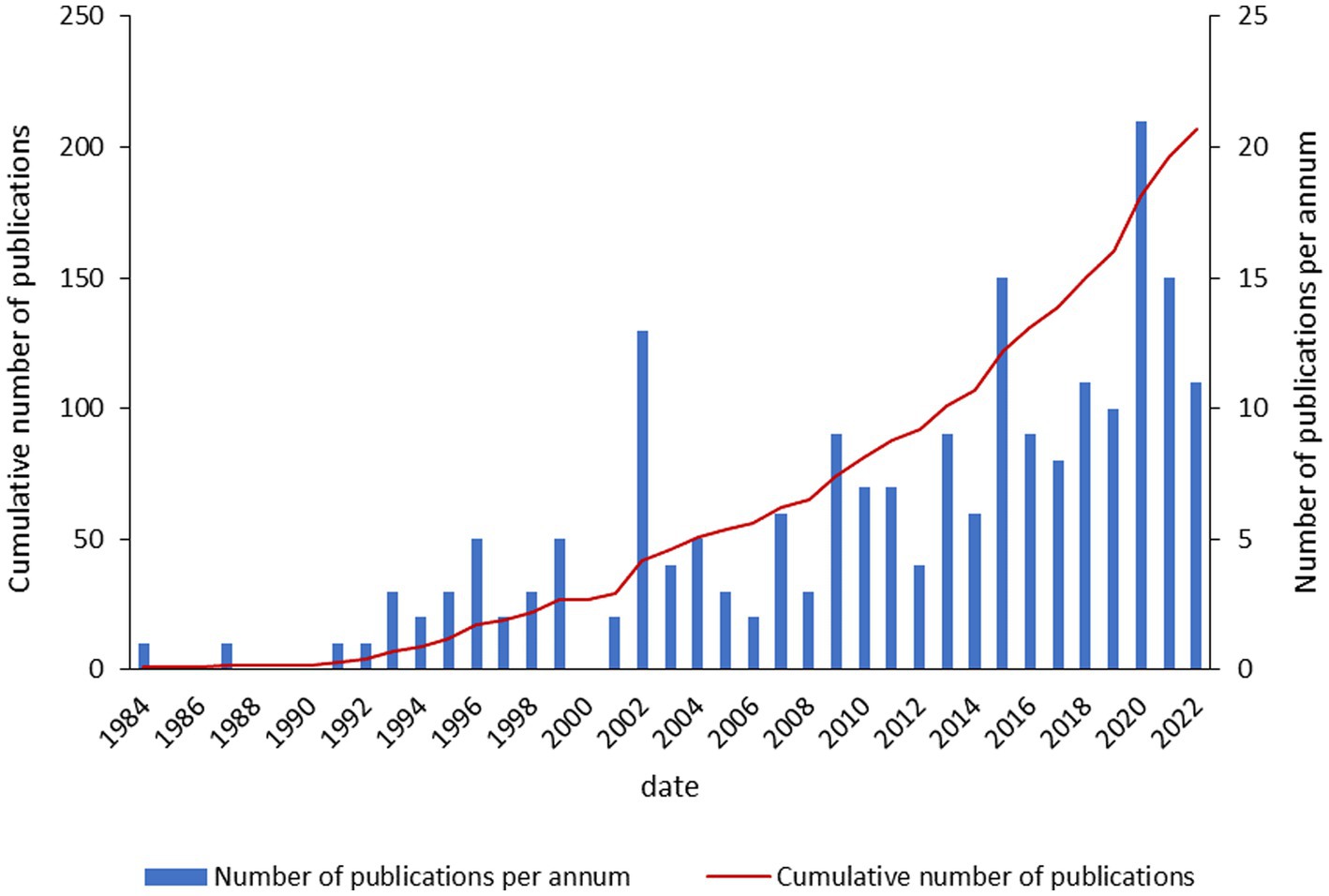
Figure 2. Annual distribution of integrated crop-livestock research in mixed farming systems of the Global South for the period 1984– 2022.
4.1.2. Geographical distribution of integrated crop-livestock research in mixed farming systems of the Global South
The geographical distribution of integrated crop-livestock research studies showed that Kenya and Ethiopia recorded the highest number of publications (22 and 28, respectively). This could be attributed to the strong presence of The International Livestock Research Institute (ILRI) in those countries and their mandate on livestock research. In Southern Africa, Zimbabwe and South Africa had the highest publications. For West Africa, several studies (19) were conducted in Nigeria, and others concentrated in the Sudanian savanna (Figure 3). In Asia, India (8) and China (7) had the highest number of publications (Figure 3). The study observed that water buffalos as part of domesticated livestock were unique to Asia, and no African countries mentioned buffalos in livestock enterprises (data not presented). Latin America had the least number of studies combined; however, with the region, Brazil and Cuba had the highest number of publications (2; Figure 3).
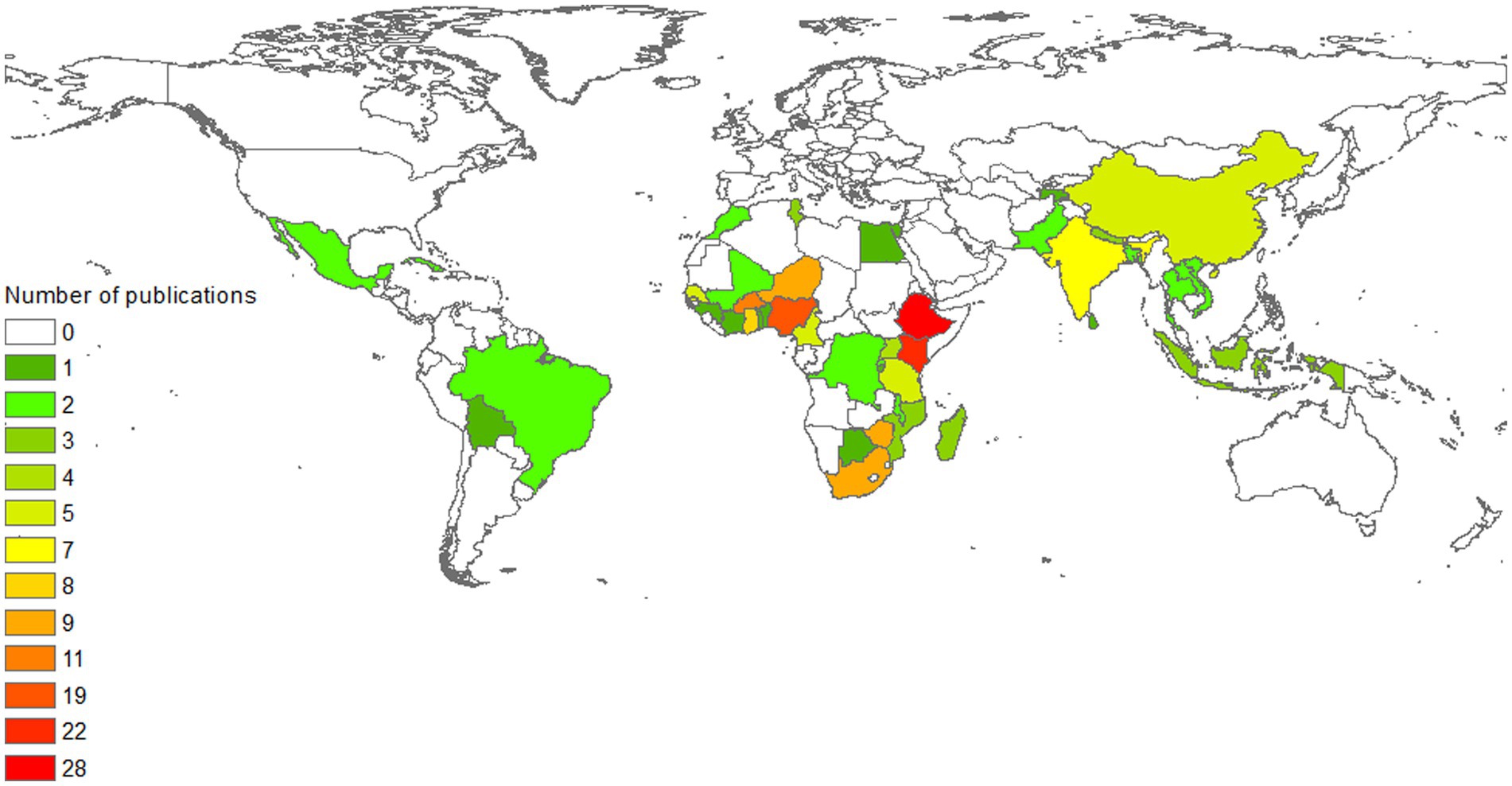
Figure 3. Geographical distribution of integrated crop-livestock research in the Global South [excludes studies with a regional (n = 7) or continent focus (n = 9)].
4.1.3. Word frequency in integrated crop-livestock research in mixed farming systems of the Global South
The word frequency search results showed that crop-livestock-based research focused on on-farm food and feed production by smallholder farmers and soil productivity (Figure 4). Two broad themes to summarize the word frequency were (i) the economic and social status of integrated crop-livestock research in MFS and (ii) the ecological status of integrated crop-livestock research in MFS. Under the former, studies looked at aspects such as availability of feed and feed, productivity, incomes and food security, while studies under the latter addressed nutrient cycling in MFS of the Global South. The farm was also a major word, suggesting that most studies were at the farm scale. Results also revealed that maize was frequently mentioned among integrated crop-livestock research studies, suggesting it is a major crop MFS for human and animal consumption (Figure 4). Cattle and sheep, both ruminants, were the most frequently mentioned livestock among crop-livestock-based research studies in MFS of the Global South.
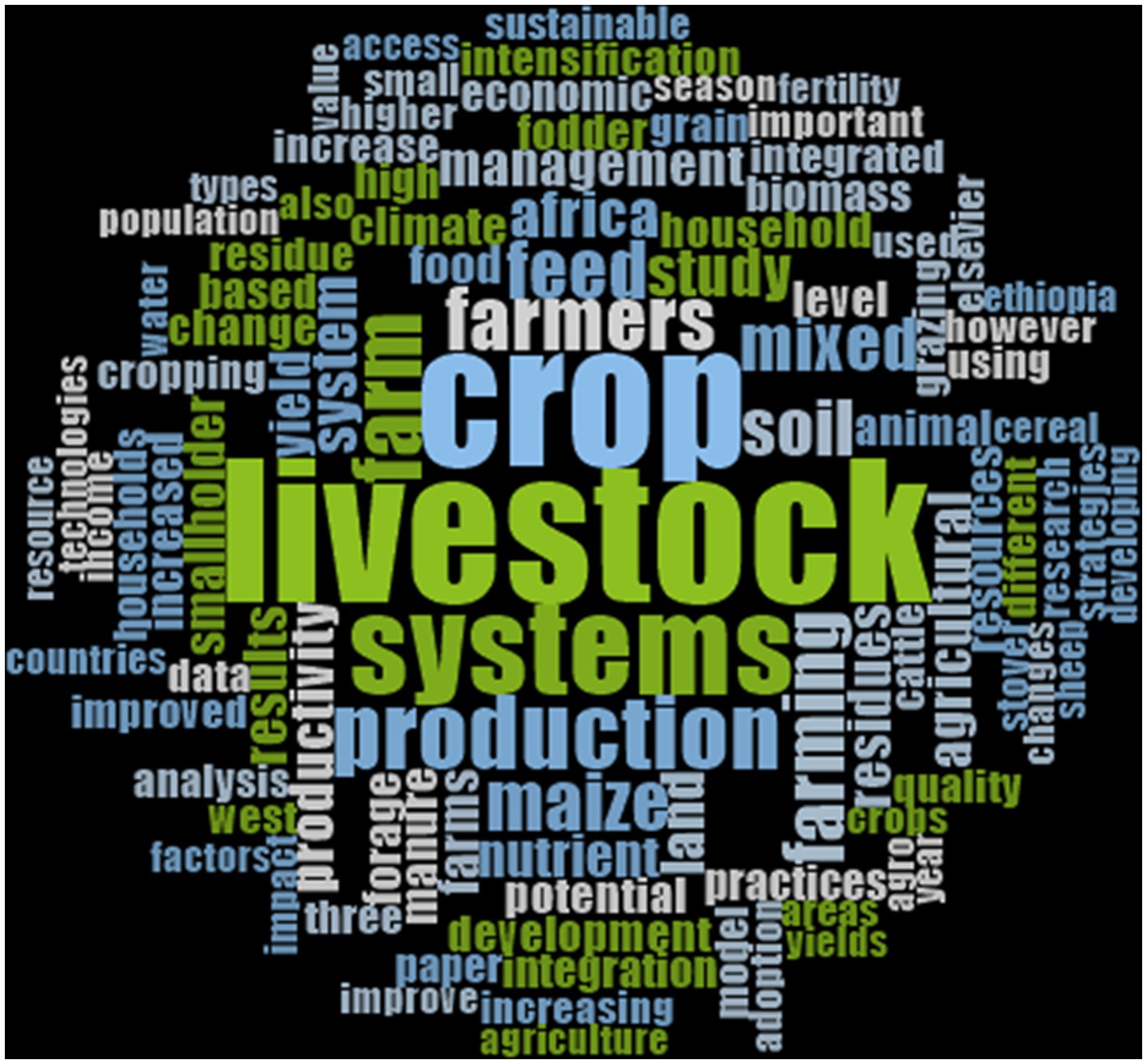
Figure 4. Word cloud generated from abstracts in an integrated crop-livestock research database for the Global South.
4.1.4. Modelling crop-livestock systems in mixed farming systems of the Global South
Whole farm models are predictive tools that combine crop and livestock systems and can be used to help improve farming systems’ efficiency and profitability. There has been progress in modelling mixed farming systems in the Global South. The review identified 10 simulation tools that have been explored to answer some research questions on MFS in the Global South (Table 2). Six of the tools [Vensim™ dynamic stock-flow feedback model, Whole-farm EPM (Econometric-process simulation model), Integrated Analysis Tool (IAT), The Simflex model, FarmDESIGN and CLIFS (Crop LIvestock Farm Simulator)] have a focus on aiding decision making for whole farm management of crop and livestock on an annual time scale from an economic point of view. Three models [TERRoir level Organic matter Interactions and Recycling model, GANESH (Goals oriented Approach to use No-till for a better Economic and environmental sustainability for Smallholders), Agent-based Model of Biomass flows in Agro-pastoral regions of West Africa (AMBAWA)] were developed to manage nutrients on the farm, especially determining the most efficient cycling of manure and crop residues (Table 2).
4.2. Problems and pressures addressed by the integrated crop-livestock research in mixed farming systems of the Global South
Studies mentioned one or more problems and pressures affecting MFS, including population growth, water scarcity, land scarcity, economic growth, food insecurity, feed insecurity, land degradation, climate change, poor productivity, disease outbreaks and social change (Table 3). Table 4 summarizes the number of times the total studies mentioned each problem. Pre-1990, there were only two studies, and the problems and/or pressures identified were economic growth, land degradation and poor productivity (Table 4). During the 1990s, most of the research addressed the shortage of animal feed, land degradation and population growth that was driving increased food demand. While it may be a surprise that the shortage of animal feed was the biggest problems in the 90s, this was because of significant land use changes during this period (Jagtap and Amissah-Arthur, 1999). Historically, livestock in smallholder MFS relied on grazing in rangelands, and these areas shrank significantly in favor of urbanization and extensification of crop production (Gavian and Ehui, 1999; Jagtap and Amissah-Arthur, 1999). Farmers were faced with the need to supplement grazing with feed. During this period, labor bottlenecks were also identified (Table 4). This coincides with the highest rural-to-urban migration period observed in developing countries (Lerch, 2020; Brown, 2021). From 2001 to 2010, the trend was the same, but studies that identified climate change as a problem for MSF in the Global South also started to increase.
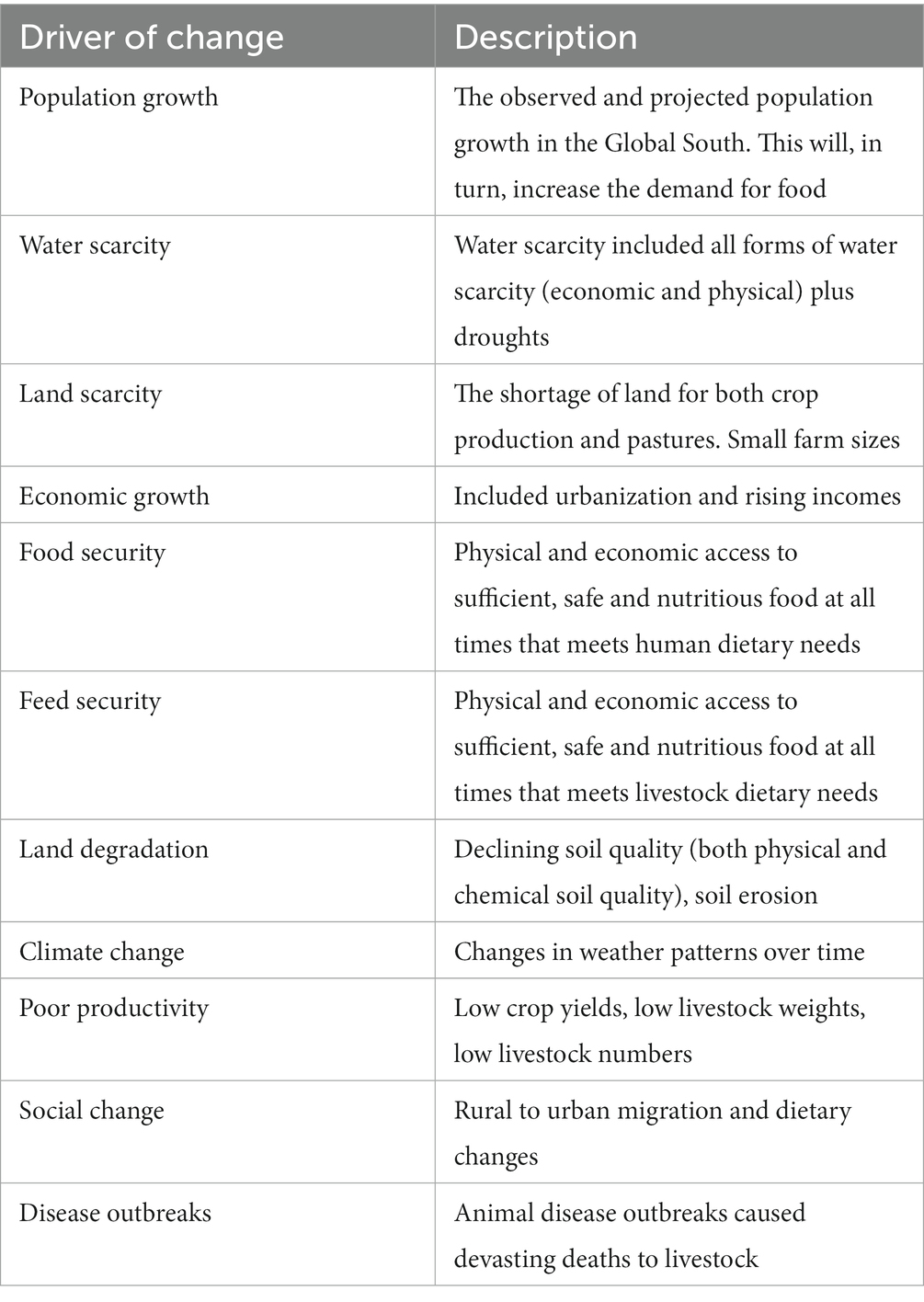
Table 3. Description of problems and pressures that the integrated crop-livestock research seeked to address.
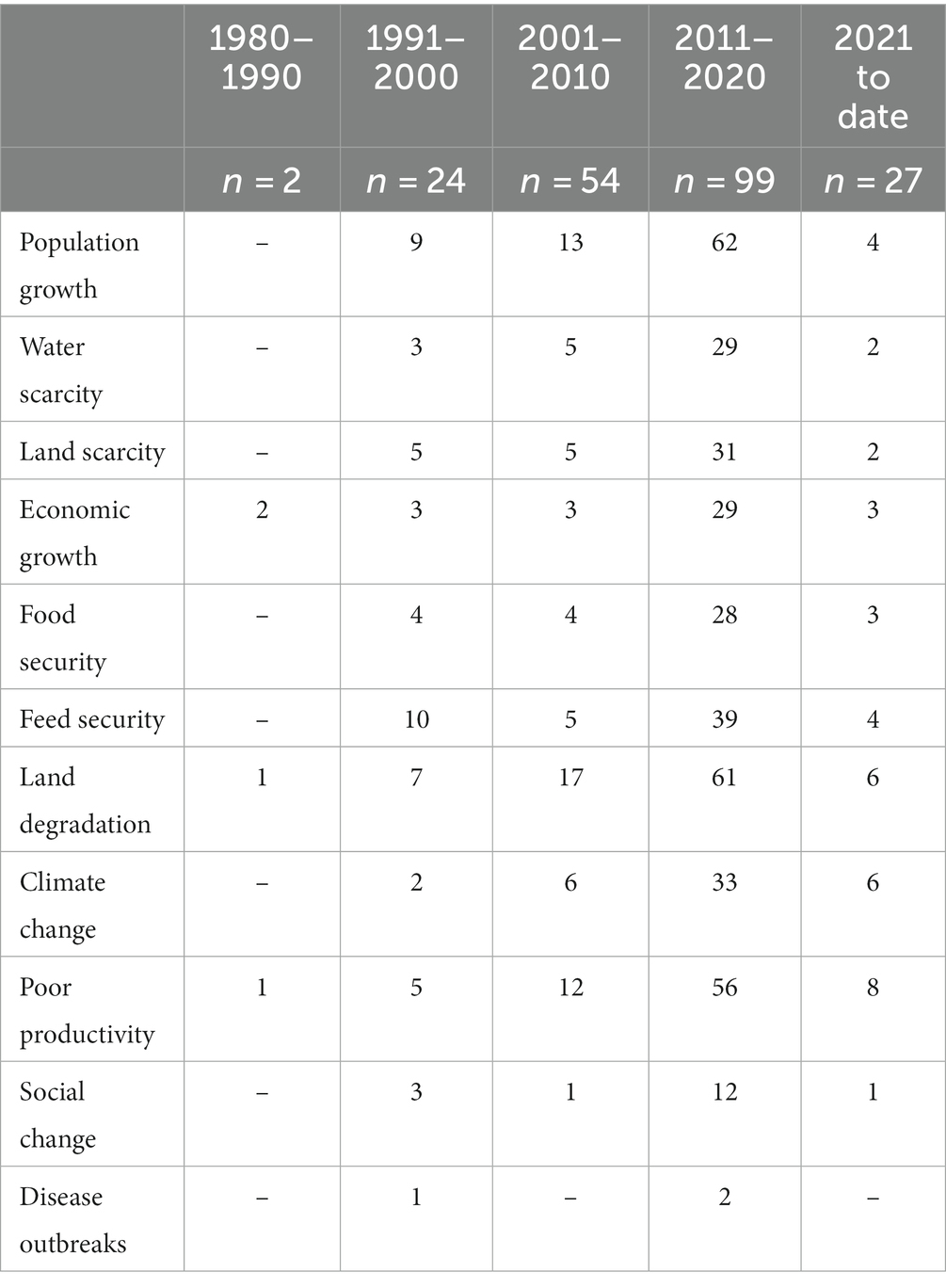
Table 4. Problems and pressures identified in the problem statements of the integrated crop- livestock research studies from 1980 to date.
Climate change directly affects MFS through seasonal shifts, climate variability and extreme weather events (Ahmad and Ma, 2020; Mihiretu et al., 2020; Mujeyi et al., 2022). Post-2010 studies addressing climate change rose approximately five times more. Farmer perceptions of climate change showed that farmers observed changes in weather variables and acknowledged climate change as a threat (Mihiretu et al., 2020). What remains a challenge is the low adaptive capacity to climate change (Ahmad and Ma, 2020; Mihiretu et al., 2020) and poor adoption of climate-smart interventions (Mujeyi et al., 2022). Food and feed insecurity were also topical from 2011 to 2020 (Table 4).
It is impossible to discuss problems or pressures in MFS as mutually exclusive. The review showed that problems or pressures in MFS were not mutually exclusive and were interlinked (Figure 5). One challenge can also perpetuate another. Problems or pressures can both be direct and indirect (Figure 5). Population growth is not only associated with increased demand for food but is a major driver in the water and land scarcity the world is currently facing. Smallholder agriculture is the major source of food in the Global South (Devendra and Thomas, 2002; Vanlauwe et al., 2014). Farm sizes in the Global South have decreased (Lowder et al., 2016), implying that any increase in crop production to mitigate food insecurity cannot be met through extensification, and livestock production cannot be sustained through rangelands and paddocks alone. Farmland degradation has been cited as one of the drivers of change in MFS. This has been attributed to unsustainable cropping and grazing practices. Unsustainable cropping practices include monoculture practices that mine nutrients in the soil, the use of synthetic fertilizers that increase soil pH and tillage practices that have contributed to soil runoff (Thorne and Tanner, 2002; Sumberg, 2003; Manlay et al., 2004; Semwal et al., 2004). Poor soil quality, among other factors such as water scarcity and climate change, has also contributed to low crop yields. Despite livestock showing potential to improve soil quality through manure, this is not fully exploited due to bottlenecks such as low livestock numbers and shortage of on-farm labor (Nkonya et al., 2005; Manyong et al., 2006; Onduru et al., 2007).
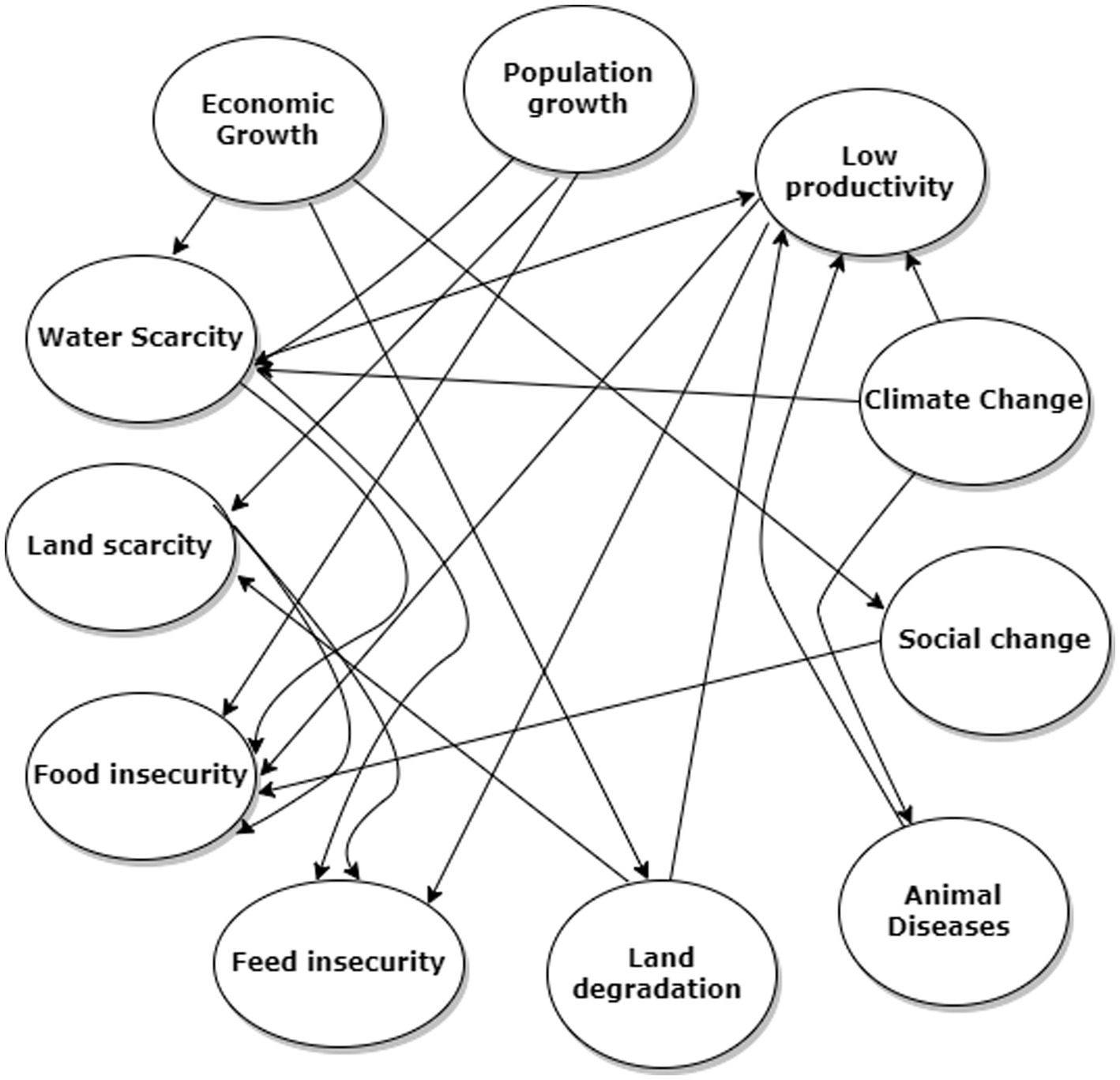
Figure 5. Linkages between problems and pressures driving integrated crop-livestock research in MFS of the Global South.
Farmers need to supplement livestock diets with expensive feed with shrinking grazing land and dry pastures during dry seasons. Alternative use of crop biomass as animal feed is not guaranteed as it depends on yield and often competes with other on-farm needs (Parthasarathy Rao and Hall, 2003). However, several studies assessed how to efficiently allocate these resources to balance healthy croplands and livestock nutrition (Naudin et al., 2015; Grillot et al., 2018; Berre et al., 2021). Growing fodder crops on cropland competes with food for human consumption. Economic growth, which also includes urbanization, has contributed to dietary changes. There is a growing preference for animal-based protein compared to plant-based protein (Herrero et al., 2010). Economic growth has also led to rural-to-urban migration of the economically active population, leading to a labor shortage for MFS (Zhou et al., 2020). Farmers have to prioritize labor allocation between the crop and livestock enterprises. Livestock disease outbreaks such as East Coast Fever and Trypanosome have also been observed to cause mortality and morbidity in livestock (Ejlertsen et al., 2012; Muhanguzi et al., 2014). Disease severance and frequency of outbreaks have been associated with climate change through conducive temperatures and other climatic conditions that encourage the reproduction and distribution of parasites and their vectors (Ali et al., 2020).
4.3. Strategies and approaches to improve mixed farming systems in the Global South
The review summarized proposed strategies and approaches to improve the efficiency of MFS in the Global South (Table 5). Interventions identified were classified into the following categories: feed and land management, food security, livestock management, climate change adaptation, policy and agribusiness (Table 5). The findings show that improving feed quality and supply through high biomass fodder and adopting improved drought-tolerant fodder crops can enhance feed production (Table 5). The availability of adequate feed resources and strategies for coping with feed scarcity ensure sustainable livestock production and food security (Mekonnen et al., 2019, 2022). With the increasing frequency and intensity of droughts in the Global South, it is important to utilize climate-smart forage grasses that combine nutrition and drought tolerance (Haileslassie et al., 2005; Descheemaeker et al., 2010). For instance, oat (Avena sativa L.)–vetch (Vicia villosa Roth) mixture, lablab [Lablab purpureus (L.) Sweet], vetch–desho grass (Pennisetum pedicellatum Trin.) intercropping, sweet lupin (Lupinus albus L.), alfalfa (Medicago sativa L.), and fodder beet (Beta vulgaris L.) showed high yield responses in farmers’ fields and ultimately animal response trials showed an increase in milk yield (Mekonnen et al., 2022). Overexploitation of grazing resources and unsustainable cropping practices result in land degradation. Nutrient cycling and controlled grazing can sustainably control land degradation (Dougill et al., 2002; Ikpe and Powell, 2002; Haileslassie et al., 2007; Diarisso et al., 2015; Epper et al., 2020; Berre et al., 2021). Nutrient budgets in MFS of Burkina Faso, showed partial balances of phosphorous were generally positive, which was also a result of phosphorous fertilizer use (Diarisso et al., 2015). Baudron et al. (2014) argued that the competition for cereal residues between livestock feeding and soil mulching should not deter conservation agriculture in MFS. Still, there is a need to strike a balance. To manage competition for food between humans and livestock, the use of dual-purpose crops such as groundnut, maize, millets and sweet potatoes was shown to ease this pressure and simultaneously improve food and fodder both in terms of quantity and nutritional quality (Larbi et al., 1999a; Claessens et al., 2008; De Groote et al., 2013; Tui et al., 2015).
Mixed farming systems in the Global South are threatened by livestock disease outbreaks that cause mortality to livestock and humans. Breeding for resistance and efficient veterinary services can prevent or control the prevailing diseases (Table 5; Bernués and Herrero, 2008; Ejlertsen et al., 2012). There is also a need to enhance farmers’ access to relevant production and marketing information for improved livestock production. Policymakers in governments, extension services, research, and livestock development partners, and private sectors can formulate policy interventions that promote access to finance and markets for subsistence MFS (Table 5; Delgado, 1989; Ajeigbe et al., 2010; Kassie et al., 2010; Ejlertsen et al., 2012; Asante et al., 2019).
Climate change presents a challenge to the productivity, sustainability and profitability of MFS. Building the resilience of smallholder farmers is important to ensure the sustainability of these systems. Diversifying production practices and using drought-tolerant crop varieties and livestock breeds are strategies for farmers to adapt to the changing climate (Table 5; Bernués and Herrero, 2008; Moritz, 2010; Fadina and Barjolle, 2018; Henderson et al., 2018; Ahmad and Ma, 2020; Conradie and Genis, 2020). Smallholder farmers need access to funds to finance adaptation practices. Climate information is also critical in guiding the adaptation needs of farmers at a local level. There should be efforts to address inequalities in MFS and support all smallholder farmers to access information, markets and finance (Devendra and Sevilla, 2002; Dougill et al., 2002; Ayantunde et al., 2018). The adoption of technologies to close the labor gap and to improve farm efficiency was identified as a strategy to improve MFS; however, there is generally poor adoption of technologies by farmers. There is a need to identify appropriate niches for technology development and interventions to improve adoption (Jabbar, 1993; Grillot et al., 2018). Decision support tools were identified as potential solutions to improve decision-making in farm design and managing limited resources for greater economic returns and land conservation (Giller et al., 2011; Naudin et al., 2015). These tools were, however, still in development and evaluation; there were no publications detailing how they have been extended to the end users (farmers and extension services).
5. Limitations of review
The review used the Preferred Reporting Items for Systematic Reviews and Meta-Analyses (PRISMA) guidelines to identify, select, appraise, and synthesize studies. Due to the choice and combinations of predefined search terms, some literature may have been excluded. The review only searched for literature in scientific databases (WoS and Science Direct), thus excluding other potential sources of “gray literature” such as dissertations and reports. Asia may also have been underrepresented in this study. Authors believe that some work is done by the Indian Council of Agricultural Research on Integrated farming system research, but most of this work has not yet been published; hence is not reflected in this review. The authors also acknowledge that there is a lot of research conducted in MFS; however, only integrated crop and livestock research was selected for this review.
6. Conclusion and recommendations
A scoping review was conducted to synthesize integrated crop-livestock research in MFS of the Global South. Crop-livestock research in the Global South dates back to the 1980s. Economic growth, land degradation and poor productivity sparked research interest in these systems during that time. In the 1990s, the shortage of animal feed was topical due to land use changes that shrunk grazing rangelands. Geographically, crop-livestock-based research was concentrated in Ethiopia, Kenya, Nigeria and the Sudanian savanna of West Africa. The focus of the crop-livestock research was on-farm production of food and feed by smallholder farmers and soil productivity, with maize being the most frequently mentioned crop and sheep and cattle being the frequently mentioned livestock. The review identified 10 simulation tools explored in the Global South to address aspects such as farm design, nutrient cycling and operational decision-making. These tools are still in the research and development phase, and there was no evidence to suggest that farmers and extension services are utilizing these tools. Piloting these technologies to the intended users and addressing any limitations that may hinder their adoption is necessary.
Problems and pressures affecting MFS included population growth, land degradation, climate change, water scarcity, economic growth, etc., but cannot be viewed individually as they are interlinked. For example, climate change can directly influence climate change through extreme events affecting crops and livestock. Indirectly, climate change promotes livestock diseases that affect the viability of MFS. It is worth mentioning that there are many other challenges affecting viability of MFS that were not addressed by this literature database. These include international trade and globalization of markets, shifts in country policies, shortening market chains, property rights, market rights and declining human health (malnutrition; Hazell and Wood, 2008; Herrero et al., 2012). Our database comprised of studies mostly addressing biophysical aspects of integrated crop-livestock research. The review identified interventions to improve viability and sustainability in MFS. These included managing land for feed and food security by introducing legume cover crops, drought-tolerant crops, forage grasses, and dual-purpose crops. Strategies such as using indigenous breeds and access to veterinary services were proposed to manage livestock mortality and morbidity. The need for appropriate policies and business models that create an enabling environment for MFS in the Global South was highlighted. While there were suggestions of coming up with the right policies for markets, investments and tenure systems, there is still need for research that unpacks any unforeseen tradeoffs, so that the policies have the intented consequence’s on farmers in MFS.
The review concludes by highlighting some gaps that can guide future research in MFS. Considering that MFS exist across almost all agroecological regions in the Global South, authors felt there was limited literature integrating crop-livestock systems. As we were doing literature screening, there was a lot of research on individual crop or livestock components. This fails to capture any synergies and tradeoffs between the two components. There is a need for research that integrates crop-livestock systems and natural resource management innovations that can be scalable under different agroecology’s of the Global South. The interaction between MFS and agricultural water management was almost lacking in the literature. Since water is a scarce resource and often limiting in smallholder systems, it is important to consider how MFS strategies respond to combinations of water management strategies and how such measures can improve production and water use efficiency (WUE). Multiple-use water services and systems (MUS) have emerged as a promising way to enhance single-water use systems’ productivity but are yet to be exploited in MFS. Water footprints have been evaluated separately for crops (Mekonnen and Hoekstra, 2011; Chu et al., 2017) and livestock (Ibidhi and Salem, 2020) and research opportunities exist for evaluating water footprints in MFS. The sustainable intensification of MFS is critical to meeting productivity goals without compromising social and ecological outcomes. Diversification in mixed systems also remains important, especially its potential to buffer against risks of climate change and the prospects of multiple ecosystem services. No single practice or strategy will suffice to achieve sustainable intensification of MFS, but rather an ensemble of approaches calibrated for local contexts and environmental conditions.
Author contributions
TM: conceptualization and critical analysis. TC: conceptualization, methodology, data curation, and writing – original draft preparation. AS: critical analysis. All authors contributed to the article and approved the submitted version.
Acknowledgments
The authors would like to acknowledge contributions from the reviewers of this review, and funding from the One CGIAR Sustainable Intensification of Mixed Farming Systems (SI-MFS) Initiative, which is grateful for the support of CGIAR Trust. Fund contributors: www.cgiar.org/funders.
Conflict of interest
The authors declare that the research was conducted in the absence of any commercial or financial relationships that could be construed as a potential conflict of interest.
Publisher’s note
All claims expressed in this article are solely those of the authors and do not necessarily represent those of their affiliated organizations, or those of the publisher, the editors and the reviewers. Any product that may be evaluated in this article, or claim that may be made by its manufacturer, is not guaranteed or endorsed by the publisher.
Supplementary material
The Supplementary material for this article can be found online at: https://www.frontiersin.org/articles/10.3389/fsufs.2023.1241675/full#supplementary-material
Footnotes
References
Abdalla, K., Mutema, M., Chivenge, P., and Chaplot, V. (2021). Controlled grazing of maize residues increased carbon sequestration in no-tillage system: a case of a smallholder farm in South Africa. Agronomy 11:1421.
Ahmad, M. I., and Ma, H. (2020). Climate change and livelihood vulnerability in mixed crop-livestock areas: the case of province Punjab, Pakistan. Sustainability (Switzerland) 12. doi: 10.3390/su12020586
Ajeigbe, H. A., Singh, B. B., Ezeaku, E., and Adeosun, J. O. (2010). On-farm evaluation of improved cowpea-cereals cropping systems for crop-livestock farmers: cereals-cowpea systems in Sudan savanna zone of Nigeria. In. Afr. J. Agric. Res. 5, 2297–2304. doi: 10.5897/AJAR.9000514
Ali, M. Z., Carlile, G., and Giasuddin, M. (2020). Impact of global climate change on livestock health: Bangladesh perspective. Open Veterinary Journal 10, 178–188. doi: 10.4314/OVJ.V10I2.7
Alomia-Hinojosa, V., Groot, J. C. J., Speelman, E. N., Bettinelli, C., McDonald, A. J., Alvarez, S., et al. (2020). Operationalizing the concept of robustness of nitrogen networks in mixed smallholder systems: a pilot study in the mid-hills and lowlands of Nepal. Ecol. Indic. 110:105883. doi: 10.1016/j.ecolind.2019.105883
Andrieu, N., Descheemaeker, K., Sanou, T., and Chia, E. (2015). Effects of technical interventions on flexibility of farming systems in Burkina Faso: lessons for the design of innovations in West Africa. Agric. Syst. 136, 125–137. doi: 10.1016/j.agsy.2015.02.010
Asante, B. O., Ennin, S. A., Osei-Adu, J., Asumadu, H., Adegbidi, A., Saho, M., et al. (2019). Performance of integrated crop-small ruminant production systems in West Africa. Agrofor. Syst. 93, 989–999. doi: 10.1007/s10457-018-0196-8
Ayantunde, A., Hiernaux, P., Fernandez-Rivera, S., and Sangare, M. (2018). Nutrient management in livestock systems in West Africa Sahel with emphasis on feed and grazing management. In improving the profitability, sustainability and efficiency of nutrients through site specific fertilizer recommendations in West Africa agro-ecosystems 1, 11–23. doi: 10.1007/978-3-319-58789-9_2
Baudron, F., Jaleta, M., Okitoi, O., and Tegegn, A. (2014). Conservation agriculture in African mixed crop-livestock systems: Expanding the niche. Agriculture, Ecosystems and Environment 187, 171–182. doi: 10.1016/j.agee.2013.08.020
Baudron, F., Mamo, A., Tirfessa, D., and Argaw, M. (2015). Impact of farmland exclosure on the productivity and sustainability of a mixed crop-livestock system in the central rift valley of ethiopia. Agriculture, Ecosystems and Environment 207, 109–118. doi: 10.1016/j.agee.2015.04.003
Bernués, A., and Herrero, M. (2008). Farm intensification and drivers of technology adoption in mixed dairy-crop systems in Santa Cruz, Bolivia. Spanish Journal of Agricultural Research 6, 279–293. doi: 10.5424/sjar/2008062-319
Berre, D., Diarisso, T., Andrieu, N., le Page, C., and Corbeels, M. (2021). Biomass flows in an agro-pastoral village in West Africa: who benefits from crop residue mulching? Agric. Syst. 187:102981. doi: 10.1016/j.agsy.2020.102981
Blümmel, M., Tui, S. H. K., Valbuena, D., Duncan, A. J., and Herrero, M. (2013). Biomass in crop-livestock systems in the context of the livestock revolution. Science et Changements Planetaires - Secheresse 24, 330–339. doi: 10.1684/sec.2013.0403
Boretti, A., and Rosa, L. (2019). Reassessing the projections of the world water development report. Npj Clean Water 2019 2:1 2, 1–6. doi: 10.1038/s41545-019-0039-9
Brown, H. C. P. (2021). Youth, migration and community forestry in the global south. Forests, Trees and Livelihoods 30, 213–225. doi: 10.1080/14728028.2021.1958065
Chu, Y., Shen, Y., and Yuan, Z. (2017). Water footprint of crop production for different crop structures in the Hebei southern plain, North China. Hydrol. Earth Syst. Sci. 21, 3061–3069. doi: 10.5194/hess-21-3061-2017
Claessens, L., Stoorvogel, J. J., and Antle, J. M. (2008). Ex ante assessment of dual-purpose sweet potato in the crop-livestock system of western Kenya: a minimum-data approach. Agric. Syst. 99, 13–22. doi: 10.1016/j.agsy.2008.09.002
Conradie, B., and Genis, A. (2020). Efficiency of a mixed farming system in a marginal winter rainfall area of the Overberg, South Africa, with implications for thinking about sustainability. Agrekon 59, 387–400. doi: 10.1080/03031853.2020.1828116
Dados, N., and Connell, R. (2012). The global south. Contexts 11, 12–13. doi: 10.1177/1536504212436479
de Groote, H., Dema, G., Sonda, G. B., and Gitonga, Z. M. (2013). Maize for food and feed in East Africa—the farmers’ perspective. Field Crop Res. 153, 22–36. doi: 10.1016/j.fcr.2013.04.005
Delgado, C. L. (1989). The changing economic context of mixed farming in savanna West Africa: a conceptual framework applied to Burkina Faso. Quarterly Journal of International Agriculture 28:351.
Descheemaeker, K., Amede, T., and Haileslassie, A. (2010). Improving water productivity in mixed crop-livestock farming systems of sub-Saharan Africa. Agric. Water Manag. 97, 579–586. doi: 10.1016/j.agwat.2009.11.012
Devendra, C., and Sevilla, C. C. (2002). Availability and use of feed resources in crop-animal systems in Asia. Agric. Syst. 71, 59–73. doi: 10.1016/S0308-521X(01)00036-1
Devendra, C., and Thomas, D. (2002). Smallholder farming systems in Asia. Agric. Syst. 71, 27–40. doi: 10.1016/S0308-521X(01)00034-8
Diarisso, T., Corbeels, M., Andrieu, N., Djamen, P., and Tittonell, P. (2015). Biomass transfers and nutrient budgets of the agro-pastoral systems in a village territory in South-Western Burkina Faso. Nutr. Cycl. Agroecosyst. 101, 295–315. doi: 10.1007/s10705-015-9679-4
Dougill, A. J., Twyman, C., Thomas, D. S. G., and Sporton, D. (2002). Soil degradation assessment in mixed farming systems of southern Africa: use of nutrient balance studies for participatory degradation monitoring. Geogr. J. 168, 195–210. doi: 10.1111/1475-4959.00048
Ejlertsen, M., Poole, J., and Marshall, K. (2012). Traditional breeding objectives and practices of goat, sheep and cattle smallholders in the Gambia and implications in relation to the design of breeding interventions. Trop. Anim. Health Prod. 45, 219–229. doi: 10.1007/s11250-012-0194-1
El-Shater, T., and Yigezu, Y. A. (2021). Can retention of crop residues on the field be justified on socioeconomic grounds? A case study from the mixed crop-livestock production systems of the moroccan drylands. Agronomy 11. doi: 10.3390/agronomy11081465
Epper, C. A., Paul, B., Burra, D., Phengsavanh, P., Ritzema, R., Syfongxay, C., et al. (2020). Nutrient flows and intensification options for smallholder farmers of the Lao uplands. Agric. Syst. 177:102694. doi: 10.1016/j.agsy.2019.102694
Fadina, A. M. R., and Barjolle, D. (2018). Farmers’ adaptation strategies to climate change and their implications in the Zou department of South Benin. Environments - MDPI 5, 1–17. doi: 10.3390/environments5010015
Gavian, S., and Ehui, S. (1999). Measuring the production efficiency of alternative land tenure contracts in a mixed crop-livestock system in Ethiopia. Agric. Econ. 20, 37–49.
Giller, K. E., Delaune, T., Silva, J. V., Descheemaeker, K., van de Ven, G., Schut, A. G. T., et al. (2021). The future of farming: who will produce our food? Food Security 13, 1073–1099. doi: 10.1007/s12571-021-01184-6
Giller, K. E., Tittonell, P., Rufino, M. C., van Wijk, M. T., Zingore, S., Mapfumo, P., et al. (2011). Communicating complexity: integrated assessment of tradeoffs concerning soil fertility management within African farming systems to support innovation and development. Agric. Syst. 104, 191–203. doi: 10.1016/j.agsy.2010.07.002
González-García, E., Gourdine, J. L., Alexandre, G., Archimède, H., and Vaarst, M. (2012). The complex nature of mixed farming systems requires multidimensional actions supported by integrative research and development efforts. Animal 6, 763–777. doi: 10.1017/S1751731111001923
Grant, M. J., and Booth, A. (2009). A typology of reviews: an analysis of 14 review types and associated methodologies. Health Information & Libraries Journal 26, 91–108. doi: 10.1111/j.1471-1842.2009.00848.x
Grillot, M., Vayssières, J., and Masse, D. (2018). Agent-based modelling as a time machine to assess nutrient cycling reorganization during past agrarian transitions in West Africa. Agric. Syst. 164, 133–151. doi: 10.1016/j.agsy.2018.04.008
Haileslassie, A., Priess, J. A., Veldkamp, E., and Lesschen, J. P. (2007). Nutrient flows and balances at the field and farm scale: exploring effects of land-use strategies and access to resources. Agric. Syst. 94, 459–470. doi: 10.1016/j.agsy.2006.11.013
Haileslassie, A., Priess, J., Veldkamp, E., Teketay, D., and Lesschen, J. P. (2005). Assessment of soil nutrient depletion and its spatial variability on smallholders’ mixed farming systems in Ethiopia using partial versus full nutrient balances. Agric. Ecosyst. Environ. 108, 1–16. doi: 10.1016/j.agee.2004.12.010
Hassen, A. S., and Tesfaye, Y. (2014). Sheep and goat production objectives in pastoral and agro-pastoral production systems in Chifra district of Afar. Ethiopia. Tropical Animal Health and Production 46, 1467–1474. doi: 10.1007/s11250-014-0668-4
Hazell, P., and Wood, S. (2008). Drivers of change in global agriculture. Philosophical Transactions of the Royal Society B: Biological Sciences 363, 495–515. doi: 10.1098/rstb.2007.2166
Henderson, B., Cacho, O., Thornton, P., van Wijk, M., and Herrero, M. (2018). The economic potential of residue management and fertilizer use to address climate change impacts on mixed smallholder farmers in Burkina Faso. Agric. Syst. 167, 195–205. doi: 10.1016/j.agsy.2018.09.012
Herrero, M., Thornton, P.K., Notenbaert, A., Msangi, S., Wood, S., Kruska, R., et al. (2012). Drivers of change in crop–livestock systems and their potential impacts on agro-ecosystems services and human wellbeing to 2030: A study commissioned by the CGIAR Systemwide livestock Programme. Nairobi, Kenya: ILRI.
Herrero, M., Thornton, P. K., Notenbaert, A. M., Wood, S., Msangi, S., Freeman, H. A., et al. (2010). Smart investments in sustainable food production: revisiting mixed crop-livestock systems. Science 327, 822–825. doi: 10.1126/science.1183725
Hou, F. (2014). Adaptation of mixed crop-livestock systems in Asia. In climate change impact and adaptation in agricultural systems (pp. 155–166). Available at: https://www.scopus.com/inward/record.uri?eid=2-s2.0-84927962020&partnerID=40&md5=b1091b14c86fde38c065f7351d8faa2e
Ibidhi, R., and Salem, H. B. (2020). Water footprint of livestock products and production systems: a review. Anim. Prod. Sci. 60, 1369–1380. doi: 10.1071/AN17705
Ikpe, F. N., and Powell, J. M. (2002). Nutrient cycling practices and changes in soil properties in the crop-livestock farming systems of western Niger Republic of West Africa. Nutr. Cycl. Agroecosyst. 62, 37–45. doi: 10.1023/A:1015199114833
Jabbar, M. A. (1993). Evolving crop-livestock farming systems in the humid zone of West Africa: potential and research needs. Outlook on Agriculture 22, 13–21. doi: 10.1177/003072709302200104
Jagtap, S., and Amissah-Arthur, A. (1999). Stratification and synthesis of crop-livestock production system using GIS. GeoJournal 47, 573–582. doi: 10.1023/A:1006995824626
Kassie, G. T., Abdulai, A., and Wollny, C. (2010). Implicit prices of indigenous bull traits in crop-livestock mixed production systems of Ethiopia. Afr. Dev. Rev. 22, 482–494. doi: 10.1111/j.1467-8268.2010.00244.x
Komarek, A. M., Bell, L. W., Whish, J. P. M., Robertson, M. J., and Bellotti, W. D. (2015). Whole-farm economic, risk and resource-use trade-offs associated with integrating forages into crop-livestock systems in western China. Agricultural Systems 133, 63–72. doi: 10.1016/j.agsy.2014.10.008
Larbi, A., Adekunle, I. O., Awojide, A., and Akinlade, J. (1999a). Identifying Chamaecrista rotundifolia accessions and Centrosema species for bridging seasonal feed gaps in smallholder mixed farms in the west African derived savanna. Tropical Grasslands 33, 91–97.
Larbi, A., Dung, D. D., Olorunju, P. E., Smith, J. W., Tanko, R. J., Muhammad, I. R., et al. (1999b). Groundnut (Arachis hypogaea) for food and fodder in crop-livestock systems: Forage and seed yields, chemical composition and rumen degradation of leaf and stem fractions of 38 cultivars. Animal Feed Science and Technology 77, 33–47. doi: 10.1016/S0377-8401(98)00238-7
la Rovere, R., Hiernaux, P., van Keulen, H., Schiere, J. B., and Szonyi, J. A. (2005). Co-evolutionary scenarios of intensification and privatization of resource use in rural communities of South-Western Niger. Agric. Syst. 83, 251–276. doi: 10.1016/j.agsy.2004.04.003
Latham, M. (1997). “Crop residues as a strategic resource in mixed farming systems” in Crop residues in sustainable mixed crop/livestock farming systems (Wallingford: CAB International, ICRISAT, ILRI), 181–196.
le Gal, P. Y., Andrieu, N., Bruelle, G., Dugué, P., Monteil, C., Moulin, C. H., et al. (2022). Modelling mixed crop-livestock farms for supporting farmers’ strategic reflections: the CLIFS approach. Comput. Electron. Agric. 192:106570. doi: 10.1016/j.compag.2021.106570
Lerch, M. (2020). International migration and city growth in the global south: an analysis of IPUMS data for seven countries, 1992–2013. Popul. Dev. Rev. 46, 557–582. doi: 10.1111/padr.12344
Lowder, S. K., Skoet, J., and Raney, T. (2016). The Number, Size, and Distribution of Farms, Smallholder Farms, and Family Farms Worldwide. World Development 87, 16–29. doi: 10.1016/J.WORLDDEV.2015.10.041
MacLaren, C., Storkey, J., Strauss, J., Swanepoel, P., and Dehnen-Schmutz, K. (2019). Livestock in diverse cropping systems improve weed management and sustain yields whilst reducing inputs. Journal of Applied Ecology 56, 144–156.
Manlay, R. J., Ickowicz, A., Masse, D., Floret, C., Richard, D., and Feller, C. (2004). Spatial carbon, nitrogen and phosphorus budget of a village in the west African savanna - I. element pools and structure of a mixed-farming system. Agric. Syst. 79, 55–81. doi: 10.1016/S0308-521X(03)00053-2
Manyong, V. M., Okike, I., and Williams, T. O. (2006). Effective dimensionality and factors affecting crop-livestock integration in west African savannas: a combination of principal component analysis and Tobit approaches. Agric. Econ. 35, 145–155. doi: 10.1111/j.1574-0862.2006.00148.x
McDonald, C. K., MacLeod, N. D., Lisson, S., and Corfield, J. P. (2019). The integrated analysis tool (IAT) – a model for the evaluation of crop-livestock and socio-economic interventions in smallholder farming systems. Agric. Syst. 176:102659. doi: 10.1016/j.agsy.2019.102659
Meena, L. R., Kochewad, S. A., Prusty, A. K., Bhanu, C., and Al, S. K. (2022). Sustainable integrated farming system model for small farm holders of Uttar Pradesh. Indian J. Agric. Sci. 92, 1080–1085. doi: 10.56093/ijas.v92i9.110742
Mekonnen, K., Bezabih, M., Thorne, P., Gebreyes, M. G., Hammond, J., and Adie, A. (2022). Feed and forage development in mixed crop–livestock systems of the Ethiopian highlands: Africa RISING project research experience. Agron. J. 114, 46–62. doi: 10.1002/agj2.20853
Mekonnen, K., Jogo, W., Bezabih, M., Mulema, A., and Thorne, P. (2019). Determinants of survival and growth of tree lucerne (Chamaecytisus palmensis) in the crop-livestock farming systems of the Ethiopian highlands. Agrofor. Syst. 93, 279–293. doi: 10.1007/s10457-016-0066-1
Mekonnen, M. M., and Hoekstra, A. Y. (2011). The green, blue and grey water footprint of crops and derived crops products. Hydrol. Earth Syst. Sci. 15, 1577–1600. doi: 10.5194/hess-15-1577-2011
Melesse, M. B., Tirra, A. N., Ojiewo, C. O., and Hauser, M. (2021). Understanding farmers’ trait preferences for dual-purpose crops to improve mixed crop–livestock systems in Zimbabwe. Sustainability (Switzerland) 13. doi: 10.3390/su13105678
Mihiretu, A., Okoyo, E. N., and Lemma, T. (2020). Small holder farmers’ perception and response mechanisms to climate change: lesson from Tekeze lowland goat and sorghum livelihood zone. Ethiopia. Cogent Food & Agriculture 6:1763647. doi: 10.1080/23311932.2020.1763647
Moher, D., Liberati, A., Tetzlaff, J., and Altman, D. G., Group*, P (2009). Preferred reporting items for systematic reviews and meta-analyses: the PRISMA statement. Ann. Intern. Med. 151, 264–269. doi: 10.7326/0003-4819-151-4-200908180-00135
Moritz, M. (2010). Crop-livestock interactions in agricultural and pastoral systems in West Africa. Agric. Hum. Values 27, 119–128. doi: 10.1007/s10460-009-9203-z
Moseley, W. G. (2022). Development assistance and Boserupian intensification under geopolitical isolation: The political ecology of a crop-livestock integration project in Burundi. Geoforum 128, 276–285. doi: 10.1016/j.geoforum.2021.01.010
Muhanguzi, D., Picozzi, K., Hatendorf, J., Thrusfield, M., Welburn, S. C., Kabasa, J. D., et al. (2014). Prevalence and spatial distribution of Theileria parva in cattle under crop-livestock farming systems in Tororo District, eastern Uganda. Parasites and Vectors 7:91. doi: 10.1186/1756-3305-7-91
Mujeyi, A., Mudhara, M., and Mutenje, M. J. (2022). Adoption patterns of climate-smart agriculture in integrated crop-livestock smallholder farming systems of Zimbabwe. Clim. Dev. 5, 399–408. doi: 10.1080/17565529.2021.1930507
Mupangwa, W., and Thierfelder, C. (2014). Intensification of conservation agriculture systems for increased livestock feed and maize production in Zimbabwe. International Journal of Agricultural Sustainability 12, 425–439. doi: 10.1080/14735903.2013.859836
Naudin, K., Bruelle, G., Salgado, P., Penot, E., Scopel, E., Lubbers, M., et al. (2015). Tradeoffs around the use of biomass for livestock feed and soil cover in dairy farms in the Alaotra lake region of Madagascar. Agric. Syst. 134, 36–47. doi: 10.1016/j.agsy.2014.03.003
Nkonya, E., Kaizzi, C., and Pender, J. (2005). Determinants of nutrient balances in a maize farming system in eastern Uganda. Agric. Syst. 85, 155–182. doi: 10.1016/j.agsy.2004.04.004
Notenbaert, A., Herrero, M., de Groote, H., You, L., Gonzalez-Estrada, E., and Blummel, M. (2013). Identifying recommendation domains for targeting dual-purpose maize-based interventions in crop-livestock systems in East Africa. Land Use Policy 30, 834–846. doi: 10.1016/j.landusepol.2012.06.016
Onduru, D. D., de Jager, A., Muchena, F. N., Gachimbi, L., and Gachini, G. N. (2007). Socio-economic factors, soil fertility management and cropping practices in mixed farming systems of sub-saharan Africa: a study in Kiambu, central highlands of Kenya. Int. J. Agric. Res. 2, 426–439. doi: 10.3923/ijar.2007.426.439
Paramesh, V., Ravisankar, N., Behera, U., Arunachalam, V., Kumar, P., Solomon Rajkumar, R., et al. (2022). Integrated farming system approaches to achieve food and nutritional security for enhancing profitability, employment, and climate resilience in India. Food and Energy Security 11. doi: 10.1002/fes3.321
Parsons, D., Nicholson, C. F., Blake, R. W., Ketterings, Q. M., Ramírez-Aviles, L., Fox, D. G., et al. (2011). Development and evaluation of an integrated simulation model for assessing smallholder crop-livestock production in Yucatán, Mexico. Agricultural Systems 104, 1–12. doi: 10.1016/j.agsy.2010.07.006
Parthasarathy Rao, P., and Hall, A. J. (2003). Importance of crop residues in crop–livestock systems in India and farmers’ perceptions of fodder quality in coarse cereals. Field Crop Res. 84, 189–198. doi: 10.1016/S0378-4290(03)00150-3
Pfeiffer, M., Hoffmann, M. P., Scheiter, S., Nelson, W., Isselstein, J., Ayisi, K., et al. (2022). Modeling the effects of alternative crop-livestock management scenarios on important ecosystem services for smallholder farming from a landscape perspective. Biogeosciences 19, 3935–3958. doi: 10.5194/bg-19-3935-2022
Pingali, P. L. (2012). Green revolution: impacts, limits, and the path ahead. Proc. Natl. Acad. Sci. 109, 12302–12308. doi: 10.1073/pnas.0912953109
Rufino, M. C., Rowe, E. C., Delve, R. J., and Giller, K. E. (2006). Nitrogen cycling efficiencies through resource-poor African crop–livestock systems. Agric. Ecosyst. Environ. 112, 261–282. doi: 10.1016/j.agee.2005.08.028
Ryschawy, J., Disenhaus, C., Bertrand, S., Allaire, G., Aznar, O., Plantureux, S., et al. (2017). Assessing multiple goods and services derived from livestock farming on a nation-wide gradient. Animal 11, 1861–1872. doi: 10.1017/S1751731117000829
Semwal, R. L., Nautiyal, S., Sen, K. K., Rana, U., Maikhuri, R. K., Rao, K. S., et al. (2004). Patterns and ecological implications of agricultural land-use changes: a case study from central Himalaya, India. Agric. Ecosyst. Environ. 102, 81–92. doi: 10.1016/S0167-8809(03)00228-7
Seré, C., van der Zijpp, A., Persley, G., and Rege, E. (2008). Dynamics of livestock production systems, drivers of change and prospects for animal genetic resources. Animal Genetic Resources/Resources Génétiques Animales/Recursos Genéticos Animales 42, 3–24. doi: 10.1017/S1014233900002510
Steinfeld, H., Wassenaar, T., and Jutzi, S. (2006). Livestock production systems in developing countries: status, drivers, trends. Rev. Sci. Tech. 25, 505–516. doi: 10.20506/rst.25.2.1677
Sumberg, J. (1998). Mixed farming in Africa: the search for order, the search for sustainability. Land Use Policy 15, 293–317. doi: 10.1016/S0264-8377(98)00022-2
Sumberg, J. (2003). Toward a dis-aggregated view of crop-livestock integration in Western Africa. Land Use Policy 20, 253–264. doi: 10.1016/S0264-8377(03)00021-8
Taddese, G., Mohamed Saleem, M. A., Abyie, A., and Wagnew, A. (2002). Impact of grazing on plant species richness, plant biomass, plant attribute, and soil physical and hydrological properties of vertisol in east African highlands. Environ. Manag. 29, 279–289. doi: 10.1007/s00267-001-0014-2
Tarawali, S., Herrero, M., Descheemaeker, K., Grings, E., and Blümmel, M. (2011). Pathways for sustainable development of mixed crop livestock systems: taking a livestock and pro-poor approach. Livest. Sci. 139, 11–21. doi: 10.1016/j.livsci.2011.03.003
Thorne, P. J., and Tanner, J. C. (2002). Livestock and nutrient cycling in crop - animal systems in Asia. Agric. Syst. 71, 111–126. doi: 10.1016/S0308-521X(01)00039-7
Thornton, P. K., van de Steeg, J., Notenbaert, A., and Herrero, M. (2009). The impacts of climate change on livestock and livestock systems in developing countries: a review of what we know and what we need to know. Agric. Syst. 101, 113–127. doi: 10.1016/j.agsy.2009.05.002
Tui, S. H.-K., Valbuena, D., Masikati, P., Descheemaeker, K., Nyamangara, J., Claessens, L., et al. (2015). Economic tradeoffs of biomass use in crop-livestock systems: exploring more sustainable options in semi-arid Zimbabwe. Agric. Syst. 134, 48–60. doi: 10.1016/j.agsy.2014.06.009
Valdivia, R. O., Antle, J. M., and Stoorvogel, J. J. (2017). Designing and evaluating sustainable development pathways for semi-subsistence crop–livestock systems: lessons from Kenya. Agricultural Economics (United Kingdom) 48, 11–26. doi: 10.1111/agec.12383
Vanlauwe, B., Coyne, D., Gockowski, J., Hauser, S., Huising, J., Masso, C., et al. (2014). Sustainable intensification and the African smallholder farmer. Curr. Opin. Environ. Sustain. 8, 15–22. doi: 10.1016/j.cosust.2014.06.001
Keywords: cattle, crop-livestock systems, fodder, food, maize, sheep, soil fertility
Citation: Mabhaudhi T, Chibarabada TP and Sikka A (2023) Status of integrated crop-livestock research in the mixed farming systems of the Global South: a scoping study. Front. Sustain. Food Syst. 7:1241675. doi: 10.3389/fsufs.2023.1241675
Edited by:
Gizaw Desta, International Crops Research Institute for the Semi-Arid Tropics (ICRISAT), EthiopiaReviewed by:
Kindu Mekonnen, International Livestock Research Institute, EthiopiaElliot Zwane, University of Limpopo, South Africa
Copyright © 2023 Mabhaudhi, Chibarabada and Sikka. This is an open-access article distributed under the terms of the Creative Commons Attribution License (CC BY). The use, distribution or reproduction in other forums is permitted, provided the original author(s) and the copyright owner(s) are credited and that the original publication in this journal is cited, in accordance with accepted academic practice. No use, distribution or reproduction is permitted which does not comply with these terms.
*Correspondence: Tafadzwanashe Mabhaudhi, VC5NYWJoYXVkaGlAY2dpYXIub3Jn; Tendai Polite Chibarabada, Q2hpYmFyYWJhZGFUQHVrem4uYWMuemE=
 Tafadzwanashe Mabhaudhi
Tafadzwanashe Mabhaudhi Tendai Polite Chibarabada
Tendai Polite Chibarabada Alok Sikka3
Alok Sikka3